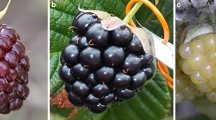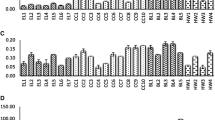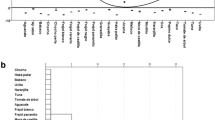Abstract
In the present study, resveratrol content and antioxidant properties of underutilized fruits such as Jamun (Syzygium cumini L.), Jackfruit (Artocarpus heterophyllus) and Mulberry (Morus rubra) were investigated keeping Grape (Vitis vinifera) as a reference. Ethanol/water (80:20 v/v) extracts of different parts of fruit samples including skin, pulp and seeds were analyzed by HPLC and MS for the quantification of resveratrol. Total polyphenols, flavonoids, DPPH scavenging activity and total antioxidant capacity were also investigated. Among the samples analyzed, mulberry fruit (whole) showed highest resveratrol content (50.61 μg g−1 dry weight) followed by jamun seed (34.87 μg g−1 dry weight), jamun pulp (13.70 μg g−1 dry weight) and skin of jamun (11.19 μg g−1 dry weight). Jamun seed extract exhibited the highest polyphenol content (55.54 mg gallic acid equivalent g−1 dry weight) and highest antioxidant property (IC50 value-0.40 mg ml−1). The results suggest that underutilized fruits high in resveratrol and other polyphenols can be used as functional beverages.


Similar content being viewed by others
References
Bae SH, Suh HJ (2007) Antioxidant activities of five different mulberry cultivars in Korea. Lebensm Wiss Technol 40:955–962
Bajpai M, Pande A, Tewari SK, Prakash D (2005) Phenolic contents and antioxidant activity of some food and medicinal plants. Int J Food Sci Nutr 56:287–291
Banerjee A, Dasgupta N, De B (2005) In vitro study of antioxidant activity of Syzygium cumini fruit. Food Chem 90:727–733
Barros L, Baptista P, Ferreira ICFR (2007) Effect of Lactarius piperatus fruiting body maturity stage on antioxidant activity measured by several biochemical assays. Food Chem Toxicol 45:1731–1737
Baur JA, Sinclair DA (2006) Therapeutic potential of resveratrol: the in vivo evidence. Nat Rev Drug Discov 5:493–506
Botterweck AAM, Verhagen H, Goldbohm RA, Kleinjans J, Van Den Brandt PA (2000) Intake of butylated hydroxyanisole and butylated hydroxytoluene and stomach cancer risk: results from analyses in the Netherlands Cohort Study. Food Chem Toxicol 38(7):599–605
Bradamante S, Barenghi L, Villa A (2004) Cardiovascular protective effects of resveratrol. Cardiovasc Drug Rev 22:169–188
Burns J, Yokota T, Ashihara H (2002) Plant foods and herbal sources of resveratrol. J Agric Food Chem 50:3337–3340
Duenas M, Hernandez T, Estrella I (2006) Assessment of in vitro antioxidant capacity of the seed coat and the cotyledon of legumes in relation to their phenolic contents. Food Chem 98:95–103
Gutteridge J, Halliwell B (2010) Antioxidants: molecules, medicines and myths. Biochem Biophys Res Commun 393(4):561–564
Heim KE, Tagliaferro AR, Bobilye DJ (2002) Flavonoid antioxidants: chemistry, metabolism and structure-activity relationships. J Nutr Biochem 13:572–584
Isabelle M, Lee BL, Ong CN (2008) Peroxyl radical scavenging capacity, polyphenolics, and lipophilic antioxidant profiles of mulberry fruits cultivated in southern china. Food Chem 56:9410–9416
Jagtap UB, Panaskar SN, Bapat VA (2010) Evaluation of antioxidant capacity and phenol content in Jackfruit (Artocarpus heterophyllus Lam.) fruit pulp. Plant Foods Hum Nutr 65:99–104
Jayatilake GS, Jayasuriya H, Lee ES (1993) Kinase inhibitors from Polygonum cuspidatum. J Nat Prod 56:1805–1810
Kalt W, Ryan DAJ, Duy JC (2001) Interspecific variation in anthocyanins, phenolics and antioxidant capacity among genotypes of high bush and low bush blueberries (Vaccinium section Cyanococcus spp.). J Agric Food Chem 49:4761–4767
Kaur C, Kapoor HC (2001) Antioxidants in fruits and vegetables- the millennium’s health. Int J Food Sci Technol 36:703–725
Langcake P, Pryce RJ (1976) The production of resveratrol by Vitis vinifera and other members of the Vitaceae as a response to infection or injury. Physiol Plant Pathol 9:77–86
Lobo V, Patil A, Phatak A, Chandra N (2010) Free radicals, antioxidants and functional foods: impact on human health. Pharmacogn Rev 4(8):118
Naik GH, Priyadarsini KI, Satav JG (2003) Comparative antioxidant activity of individual herbal components used in Ayurvedic medicine. Phytochemistry 63:97–104
Pezzuto JM (2008) Grapes and human health: a perspective. J Agric Food Chem 56:6777–6784
Prieto P, Pineda M, Aguilar M (1999) Spectrophotometric quantitation of antioxidant capacity through the formation of a phosphomolybdenum complex: specific application to the determination of vitamin E. Anal Biochem 269:337–341
Quiros AR, Lopez-Hernandez J, Ferraces-Casais P (2007) Analysis of non-anthocyanin phenolic compounds in wine samples using high performance liquid chromatography with ultraviolet and fluorescence detection. J Sep Sci 30:1262–1266
Ravindran C, Kohli A, Murthy BNS (2007) Fruit production in India. Chronica Horticuturae 47:21–26
Rimando AM, Kalt W, Magee JB (2004) Resveratrol, pterostilbene, and piceatannol in vaccinium berries. J Agric Food Chem 52:4713–4719
Rodriguez-Saona LE, Wrolstad RE (2001) Unit F2.1, Anthocyanins. Extraction, isolation and purification of anthocyanins. In: King S, Gates M, Scalettar L (eds) Current protocols in food analytical chemistry. John Wiley & Sons, Inc, New York, p 1–11
Ruxton CHS, Gardner JE, Walker D (2006) Can pure fruit and vegetable juice protect against cancer and cardiovascular disease too? A review of the evidence. Int J Food Sci Nutr 57:249–272
Sanders TH, McMichael RW, Hendrix KW (2000) Occurrence of resveratrol in edible peanuts. J Agric Food Chem 48:1243–1246
Siemann EH, Creasy LL (1992) Concentration of the phytoalexin resveratrol in wine. Am J Enol Viticult 43:49–52
Singleton VL, Rossi JA (1965) Colorimetry of total phenolics with phosphomolybdic–phosphotungstic acid reagents. Am J Enol Viticult 16:144–158
Soong YY, Barlow PJ (2004) Antioxidant activity and phenolic content of selected fruit seeds. Food Chem 88:411–417
Soong YY, Barlow PJ (2006) Quantification of gallic acid and ellagic acid from longan (Dimocarpus longan Lour.) seed and mango (Mangifera indica L.) kernel and their effects on antioxidant activity. Food Chem 97:524–530
Sung J, Lee J (2010) Antioxidant and antiproliferative activities of grape seeds from different cultivars. Food Sci Biotechnol 19:321–326
Thomas-Barberan FA, Espin JC (2001) Phenolic compounds and related enzymes as determinants of quality of fruits and vegetables. J Sci Food Agric 81:853–876
Tokusoglu O, Una MK, Yemis F (2005) Determination of the phytoalexin resveratrol (3, 5, 4′ trihydroxystilbene) in peanuts and pistachios by high-performance liquid chromatographic diode array (HPLC-DAD) and gas chromatography–mass spectrometry (GC-MS). J Agric Food Chem 53:5003–5009
Vastano BC, Chen Y, Zhu N (2000) Isolation and identification of stilbenes in two varieties of Polygonum cuspidatum. J Agric Food Chem 48:253–256
Vitrac X, Bornet AL, Vanderlinde R (2005) Determination of Stilbenes (α-viniferin, trans-astringin, trans-piceid, cis- and trans-resveratrol, €-viniferin) in Brazilian Wines. J Agric Food Chem 53:5664–5669
Wang Y, Catana F, Yang Y (2002) An LC-MS method for analysing total resveratrol in grape juice, cranberry juice, and in wine. J Agric Food Chem 50:431–435
Zhishen J, Mengcheng T, Jianming W (1999) The determination of flavonoid contents in mulberry and their scavenging effects on superoxide radicals. Food Chem 64:555–559
Acknowledgments
The authors Akshatha H.S and Anbarasu K thank Indian Council of Medical Research (ICMR) and Council of Scientific and Industrial Research-Central Food Technological Research Institute (CSIR-CFTRI), Mysore-570020, INDIA for funding the fellowships.
Author information
Authors and Affiliations
Corresponding author
Rights and permissions
About this article
Cite this article
Shrikanta, A., Kumar, A. & Govindaswamy, V. Resveratrol content and antioxidant properties of underutilized fruits. J Food Sci Technol 52, 383–390 (2015). https://doi.org/10.1007/s13197-013-0993-z
Revised:
Accepted:
Published:
Issue Date:
DOI: https://doi.org/10.1007/s13197-013-0993-z




